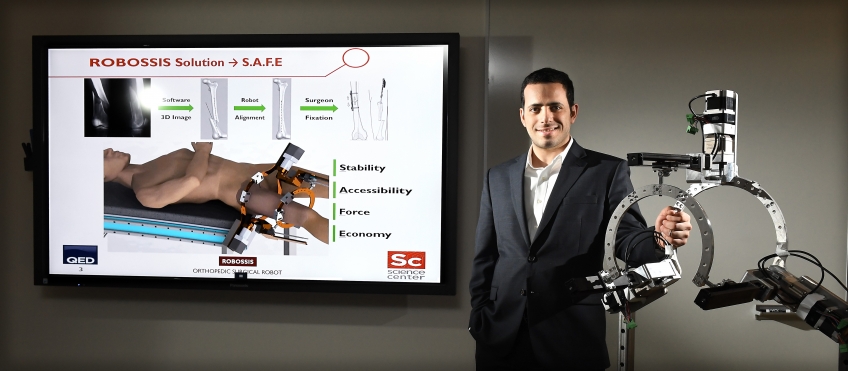 Will use $100,000 on biomedical surgical device
Will use $100,000 on biomedical surgical device
February 16, 2017
Patients with broken legs soon may undergo more successful surgeries thanks to a robot.
That’s the goal of Dr. Mohammad Abedin-Nasab, a research assistant professor of biomedical engineering in the Henry M. Rowan College of Engineering at Rowan University, Glassboro, New Jersey.
Abedin-Nasab has developed a robotic device that can assist surgeons in treating patients with broken femurs and other bones in a manner that will enable them to heal a little faster with fewer complications.
University City Science Center awards grant
The University City Science Center is helping him reach that goal.
The Philadelphia-based organization recently awarded him one of three QED Program grants of $100,000 to develop proof of concept for “Robossis™: Orthopedic Surgical Robot.” More than 60 researchers applied for funding; the Science Center awarded the other grants to professors from the University of Pennsylvania and Penn State University. The QED Program helps to design projects that are milestone-driven and focused on answering key questions that will help move technologies from the lab into the marketplace, according to the Science Center. The Science Center provides mentors for the researchers and works with university Technology Transfer Offices to help bring products to market.
“Americans suffer more than 350,000 femur fractures a year that require surgery,” said Abedin-Nasab, who is director of the Surgical Robotics Lab in Rowan’s Department of Biomedical Engineering.
He noted current surgical protocols require a surgeon to manually align the bones in a femur fracture using a trial-and-error approach, an approach that leads to malalignment of bone fragments 18 percent of the time.
Device helps surgeons
Robossis will assist surgeons with pre-operative planning and actual surgery.
The metal device includes a circular opening to accommodate a broken leg. Using imaging software connected to an X-ray machine and integrated into the robot so that it can provide a 3D image of the leg, Robossis will enable surgeons to get a clear picture of the break and visualize the optimum path of the robot to follow as it exerts pressure to align the broken pieces of bone. Surgeons then can use their preferred technique to perform the procedure.
“We’re not going to replace the surgeon; we’re just going to aid the surgeon,” said the professor, who has been working on Robossis for three years.
He will use the Science Center funding and matching $100,000 from Rowan to continue work on his prototype and assess its functionality and production feasibility. Abedin-Nasab has one international patent and three pending U.S. patents on Robossis, named for “robot” and “ossis,” Latin for “bone.”
“Robossis will benefit surgeons and hospitals, as well as patients,” said Abedin-Nasab, who earned a bachelor’s, master’s and doctoral degree in mechanical engineering in his native Iran. “The robot will enable physicians to minimize the time and money spent on the procedures by decreasing surgery times and avoiding repeated operations.”
Improves life for patients
For patients, the added benefits include less exposure to radiation (going from about 80 X-rays to as few as two), less pain and faster recovery, decreased time in the operating room, fewer and shorter hospital stays, a lower risk of infection and less blood loss.
According to Abedin-Nasab, it takes a tremendous amount of force to align broken femur bones, and that increases the danger of soft tissue damage. Complicated cases can lead to greater blood loss, secondary infections and possible longer hospital stays.
“Unfortunately, the potential problems of this trial-and-error approach are widely accepted as limitations of current medical practice, due to the lack of a better alternative,” Abedin-Nasab said.
In the near future, he and his team will develop the software needed to interface between X-ray equipment and the robot and will conduct experiments on artificial bones.
This is the first time the Science Center has awarded QED funding to a Rowan professor. Working with Abedin-Nasab on the project are biomedical engineering undergraduate students Daniel Infusino, Matthew Goldner, Nicholas Silva and Caroline Smith.
About the University City Science Center
Located in the heart of uCity Square, the Science Center is a mission-driven nonprofit organization that catalyzes and connects innovation to entrepreneurship and technology commercialization. For 50+ years, the Science Center has supported startups, research, and economic development in the life sciences, healthcare, physical sciences and emerging technology sectors. As a result, graduate firms and current residents of the Science Center’s incubator support one out of every 100 jobs in the Greater Philadelphia region and drive $13 billion in economic activity in the region annually. By providing resources and programming for any stage of a business’s lifecycle, the Science Center helps scientists, entrepreneurs and innovators take their concepts from idea to IPO – and beyond. For more information about the Science Center, go to www.sciencecenter.org.
About QED
QED is a proof-of-concept program that provides business development support for academic researchers developing early-stage life science and healthcare IT technologies. The key goal is to reduce the business risk in these early-stage projects, increasing their attractiveness to follow-on investments. Each of the recent 11 selected finalists were paired with several business partners to further develop their proof of concept and to develop a financial plan moving forward. Of the 11 finalists, Abedin-Nasab was then selected as one of three awardees who will each receive a $100,000 grant from QED. Rowan will match that $100,000 for him to carry out the proof-of-concept plan and to further validate his research.
